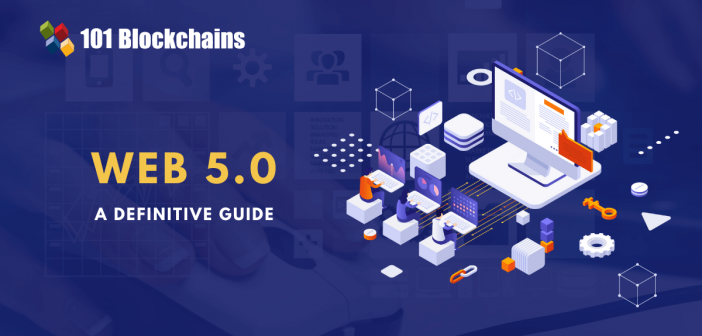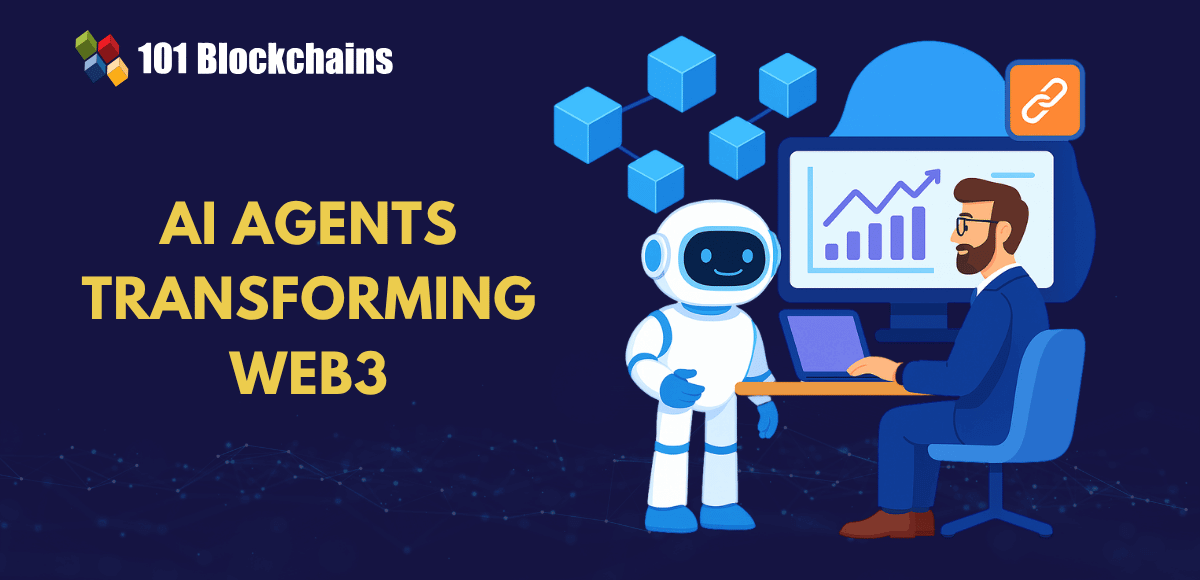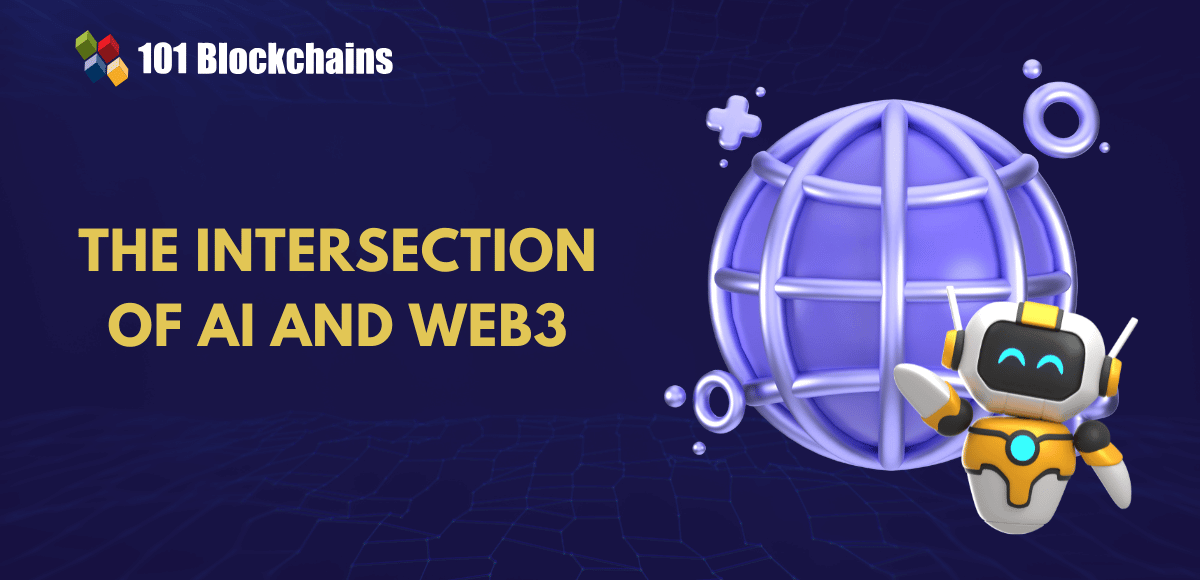Learn how blockchain truly works, master key definitions, and uncover what makes smart contracts so "smart." Dive into the fundamentals, gain valuable insights, and start your blockchain journey today!

- Web3
Georgia Weston
- on July 08, 2022
What is Web 5.0 – Explained
Did you hear about the Web 5.0, the most recent transformative version of the web? Let’s dive in to learn about the Web 5.0 explained here in detail.
The internet is not the way it used to be, and it will continue to change further in the future. Since the introduction of the internet in 1993, many applications have been created to change the lives of normal people. The assurance of a better user experience with the power of internet served as a vital boost for adoption of the internet.
As the discussion on the evolution of internet shifts towards web 5.0, it is important to look for a proper web 5.0 definition and what it entails. The following post helps you reflect on the transition of the internet from web 1.0 to web 5.0. You can understand the distinct features of web 5.0 alongside the advantages and limitations associated with the new version of the internet.
Stages in the Evolution of the Internet
The web has evolved through multiple stages to reach the phase of conceptualizing web 5.0. Any outline of web 5.0 explained in detail would also focus on the transition between different versions of the web. What are the factors responsible for driving the changes in different stages of the evolution of web? Here is a brief overview of the changes in the web over the years.
-
Web 1.0
The first version of the internet, web 1.0, focused more on read-only applications. During this stage, websites primarily served the role of setting an online presence for delivery of content.
-
Web 2.0
Web 2.0 implied the beginning of the read-write web, which offered the facility for interaction alongside effective control to users. Some of the big tech giants we know today, such as Facebook and Twitter, thrived in the web 2.0 era of the internet.
-
Web 3.0
The onset of discussions on “What is Web 5.0” appears reasonable considering the development of web 3.0. Also defined as the semantic web, web 3.0 features integration, data, automation, and discovery alongside encouraging globalization and mobility. With the power of decentralization, web 3.0 aims to offer the best of AI, machine learning, and spatial 3D computing.
-
Web 4.0
The concept of web 4.0 relies heavily on functionality. It focuses on using wireless communication to enable connectivity between people and connected objects in physical and virtual worlds. Some tech enthusiasts have also termed web 4.0 as the symbiotic web, signaling the existence of humans and computers in a symbiotic relationship.
Get familiar with the terms related to Web 3.0 with Web 3.0 Flashcards
Definition of Web 5.0
Considering the scale of improvements introduced by the previous versions of the web, it is important to wonder about the reasons for introducing web 5.0. However, let us start with a clear web 5.0 definition to develop a better impression of what it is capable of. Web 5.0 has been designed as a decentralized web platform that can allow the flexibility and resources for developing decentralized web applications.
The primary objective of web 5.0 would focus on empowering users to reclaim control and ownership of their data. As of now, the web 5.0 version is still under development. However, some experts have pointed out that web 5.0 would be more of a combination between web 2.0 and web 3.0.
What will be the advantage in a web5 blockchain environment when you can have the same benefit with web3? Web 5.0 would not only create a decentralized web platform with semantic capabilities but also introduce emotional intelligence on the web. The vision behind web 5.0 focuses profoundly on enabling emotional connection between humans and computers.
You can think of possibilities with web 5.0 examples, such as a website that can map the emotions of a person. The website can use facial recognition as a tool for mapping the person’s emotions when the user wears a headphone. Users can interact with the website, and the website would respond accordingly based on emotions of the person.
Learn the fundamentals, challenges and use cases of Web3.0 blockchain from the E-book: An Introduction To Web 3.0 Blockchain
Origins of Web 5.0
If you are seeking real examples of use cases for web 5.0, then you are a bit early. Jack Dorsey, the ex-CEO of Twitter, announced the web 5.0 project recently, following his criticism of web 3.0. Dorsey has pointed out the existing limitations in web 3.0 by stating that ownership is still a myth as venture capitalists and limited partnerships would take on a major share of the web. According to Dorsey, web 3.0 would maintain centralization in many aspects, thereby calling for development of web 5.0.
The development of web 5.0 is an important highlight in guides on “what is web 5.0,” and most important of all, everyone wants to know who will develop web 5.0. The Bitcoin business unit of Block, Inc. would take charge of the development of web 5.0. Jack Dorsey announced in June 2022 that the Bitcoin business unit of his financial payments company, The Block Head or TBD, would work on developing web5. TBD believes that web 5.0 would introduce improved control of users over data storage and decentralized identity. As of now, the web 5.0 project falls under the scope of open-source development, with more time remaining for a specific release date of the platform.
Most important of all, Mike Brock, the leader of TBD, has pointed out some remarks about the web5 blockchain assumptions. He has assured that the web 5.0 platform of TBD would be considerably different from another web 5.0 models by including more than just the value of blockchain technology. However, the team would experience many challenges in discarding the assumptions regarding decentralization of the internet.
Working of Web 5.0
The details of web 5.0 explained clearly would also reflect on the working of web5, as it helps in developing a better understanding of the concept. You can assume a simple example to understand the working of web 5.0. Have you ever wondered how virtual assistants can predict the needs of users by interpreting their behaviors? The concept of web 5.0 basically introduces a predictive virtual assistant, but on a broader scale. Web 5.0 could facilitate easier interpretation of various pieces of information on various complex levels. The internet would interpret information with logic as well as emotion in web 5.0.
The working of 5.0 also emphasizes how the use cases for web 5.0 can find a place in the everyday lives of people. As a matter of fact, web5 would be organically associated with almost every activity of an individual. Web 5.0 would capitalize on the power of AI for empowering communication between computers alongside making interactions between humans and computers similar to interactions between humans. Web 5.0 also proposes completely new and exclusive experiences to each user based on their emotions. The future developments in the domain of blockchain, AI, and machine learning would serve as inputs in improving web 5.0.
Excited to know how blockchain is connected with web 3.0? Check the detailed guide Now on The Role Of Blockchain In Web 3.0
Important Features in Web 5.0
You cannot complete a discussion on web 5.0 without an explanation of web 5.0 features and how they are better. However, it is also important to note that web5 is still under development, thereby leaving limited clarity regarding its features. On the other hand, users can expect a wide range of features once the platform has been developed and implemented. At the same time, you cannot ignore the two most significant features highlighted in the web 5.0 definition. Users can get total control over their identity and true ownership over their data.
-
Control over Your Identity
An overview of the prime use cases for web 5.0 would focus on empowering users with control of their identity. Assume that an individual, John, has a digital wallet that helps her manage authorizations, identity credentials, and her data for connecting with different apps and external connections.
John can use the wallet to enter his sign-in credentials with a decentralized social media app. The application knows their identity of John, and he wouldn’t have to create a profile. Any interactions John makes with the app would be stored on a decentralized web node. Now, John could switch to other social media apps, along with her social persona created on the present social media app.
-
Data Ownership
One of the significant highlights of web 5.0 explained clearly also draws attention to data ownership. Decentralized web implied the promise of offering true ownership of user data. However, centralization is still a concern with the supposedly “decentralized” web. On the contrary, web 5.0 aims to empower users so that they have ownership over their data.
Let us assume another choice of web 5.0 examples to understand its features. Ryan loves movies and cannot afford to have his personal data locked with one streaming service provider. In order to achieve the personal data storage approach, Ryan must find similar movies alongside creating similar watch lists on every streaming app. Bring in web 5.0, and Ryan can have more than the advantages of decentralization.
The web 5.0 features for enabling true user data ownership could help Ryan store his preferences and settings on a decentralized web node. Now, with the different streaming apps, Ryan users can access the preferences and settings on the decentralized web node. As a result, Ryan could have a seamless and personalized movie-watching experience across different platforms.
Advantages and Drawbacks of Web 5.0
Web 5.0 is under development now, and there is a lot of time before the world familiarizes with use cases for web 5.0 in real-life scenarios. However, that cannot stop anyone from wondering about the potential benefits it can introduce for users. At the same time, it is also important to take note of the setbacks with web 5.0, which can influence user experiences. Here is an outline of the most notable value advantages of the web 5.0 platform.
- The emotional intelligence aspect of web 5.0 would provide the ideal platform for users to expand their creativity.
- The ecommerce sector can capitalize on the emotional intelligence element in web 5.0 for developing the infrastructure for real-time communication with users. With a specific focus on interpreting the emotions of users, ecommerce sector can leverage web 5.0 to improve value in user experiences.
- One of the significant and recurring highlights in an overview of web 5.0 explained points at the benefits of control over your own identity and data. The existing versions of the web are centralized in nature, and the ones who claim better decentralization don’t stand true to their claims. Web 5.0 would let you maintain complete control over your data and decide how to use it. Users can also use their digital identity securely across multiple applications and services.
- Speaking of security, the foundations of web 5.0 would develop on the basis of inspiration from Bitcoin. Jack Dorsey believes that Bitcoin is the most secure decentralized network and settles the doubts about web5 blockchain equation to rest. Web 5.0 would offer the benefits of decentralization and cryptographic security to users with the help of blockchain.
Even if web 5.0 presents some credible advantages, the platform has also been subject to considerable downsides. First of all, the web 5.0 project is still under development, and no one knows how the project will shape up. On top of it, the benefits of web 5.0 would depend profoundly on large-scale adoption.
Curious to develop an in-depth understanding of web3 application architecture? Enroll Now in Web3 Application Development Course!
Future of Web 5.0
The future of web 5.0 is quite unclear as of now, especially without any detailed roadmap. Web5 focuses on developing completely decentralized solutions which can allow financial interactions and social communication. At the same time, the need for safeguarding control over user data and identity is also a critical concern for web 5.0. As of now, The Block Head or TBD focuses on developing four important components of web 5.0. The components include a decentralized web node and decentralized identifiers. The other components for web 5.0 are a self-sovereign identity service and a self-sovereign identity SDK.
Build your fluency in advanced technologies as a web3 expert, Enroll Now in world leading Web3 Expert Career Path
Bottom Line
The views of Jack Dorsey regarding web 3.0 served as the foundation for discussions on ‘what is web 5.0’ right now. Many of you might assume that web 5.0 is basically the fantasy of a tech magnate who has discovered a new love in cryptocurrencies and blockchain. Well, there is no way to undermine the capabilities of Jack Dorsey for innovation and technological advancement. At the same time, the value advantages of web 5.0 and the possible benefits show how it can transform the web. Explore to learn more about web 5.0 to broaden your knowledge.
*Disclaimer: The article should not be taken as, and is not intended to provide any investment advice. Claims made in this article do not constitute investment advice and should not be taken as such. 101 Blockchains shall not be responsible for any loss sustained by any person who relies on this article. Do your own research!








